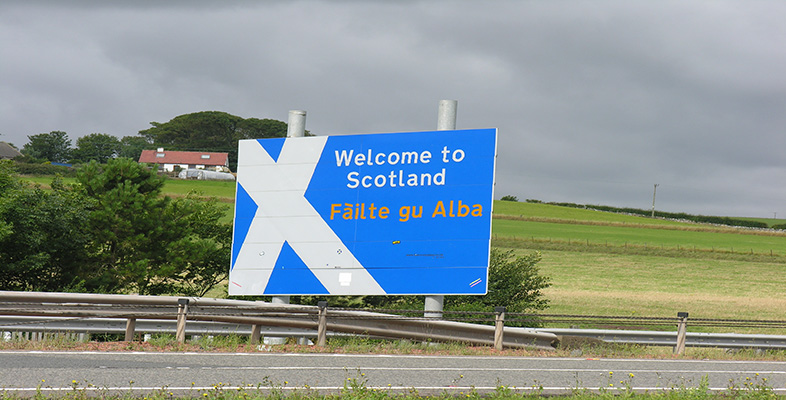1.3 Place name evidence
The spread of Gaelic across Scotland is demonstrated by the place names left behind by Gaelic-speakers. In some cases the Gaels adapted names created earlier by Pictish, Cumbric, Norse, or even English speakers, but in many instances they created their own nomenclature anew (some of which became modified in turn by other linguistic groups).
A classic Gaelic naming element is baile7, a place of permanent settlement as small as a farm but as large as a village or town, usually anglicized as bal-, balla- or occasionally bella-. The distribution of baile names demonstrates the historic spread of the Gaelic-speaking population across Scotland, with a large number in Aberdeenshire, Angus and Fife, and examples found, for example, in Kirkcudbrightshire (Balcary, Balmaclellan, Balmingan), Dumfriesshire (Ballaggan, Baltersan), Selkirkshire (Balnakiel) and East Lothian (Balgone, Ballencrieff).
Another naming element is achadh8 (often shortened to acha- or ach-), originally a ‘field’ but which became applied to settlements. The only parts of Scotland where these are rare are the far south-east, possibly because the Gaels who settled there did not work the land to any great degree, and the Western Isles, owing to the influence of Norse terminology there. In the south and east of the country, the anglicised form is usually auch-; examples include Auchinbo and Auchintoul (Aberdeenshire), Auchendinny and Auchendoon in Midlothian, and Auchabrick and Auchenree in Wigtownshire. Examples in the Highlands include Achachork and Achnacloich (Skye), Achanalt and Achnashellach (Ross-shire) and Achavanich (Caithness).
While the oldest names can sometimes pose problems of interpretation, the later (generally Highland) names are mostly transparent. For example, Achachork is Achadh a’ Choirce (the field of the oats), Achnacloich is Achadh na Cloiche (the field of the stone), Achanalt is Achadh nan Allt (the field of the burns) and Achnashellach is Achadh nan Seileach (the field of the willows).
Other Gaelic place name elements which have a wide distribution in Scotland include kil- (Gaelic cill ‘church, churchyard’), tully or tilly- (Gaelic tulach, ‘hillock, knoll’) and knock (Gaelic cnoc, ‘hill’).
Examples of the first are Kilmarnock, Kilbirnie and Kilpatrick (Ayrshire), Kilbride (several, including Lanarkshire and Argyll), Kilallan (Renfrewshire), Kilfeddar (Wigtownshire), Kilbucho (Peeblesshire), Kilconquhar (Fife) and Kildrummy (Aberdeenshire).
Tulach examples include Tillydrine, Tillyfourie and Tillytarmont (Aberdeenshire) and Tullybelton, Tullyfergus and Tullymurdoch (Perthshire).
Knock is found in Big Knock (Peeblesshire), East and West Knock (Angus) and many places simply called Knock or The Knock.
In the Gàidhealtachd, the Ordnance Survey collected not anglicised versions of Gaelic originals as in the examples above, but thousands of pure Gaelic names, some of them going back to the earliest days of Dál Riata, but others much more modern. A great number of these are morphologically complex and pose a map-reading challenge to many Scots today, but they also provide a fantastically rich thread within the nation’s cultural tapestry.
Take, for example, Meall a’ Choire Chreagaich (the lump-shaped hill of the craggy corrie), Cnoc Alltan Iain Duinn (the hill of the small burn of brown-haired John), Allt Cnoc Àirigh an t-Seilich Bhig (the burn of the hill of the shieling of the small willow), and Rubha Camas nam Meanbh-chuileag (the headland of the bay of the midges).
Use the audio links below to listen to the pronunciations of these names:
If you are interested in hearing the correct pronunciation of the names of the Munros – Scotland’s mountains over 3,000 ft – click here [Tip: hold Ctrl and click a link to open it in a new tab. (Hide tip)] .
Use the map below to explore the Gaelic and anglicised versions of the names of some well-known cities and towns in Scotland. Click on each place name to see its origin and hear its Gaelic pronunciation.
